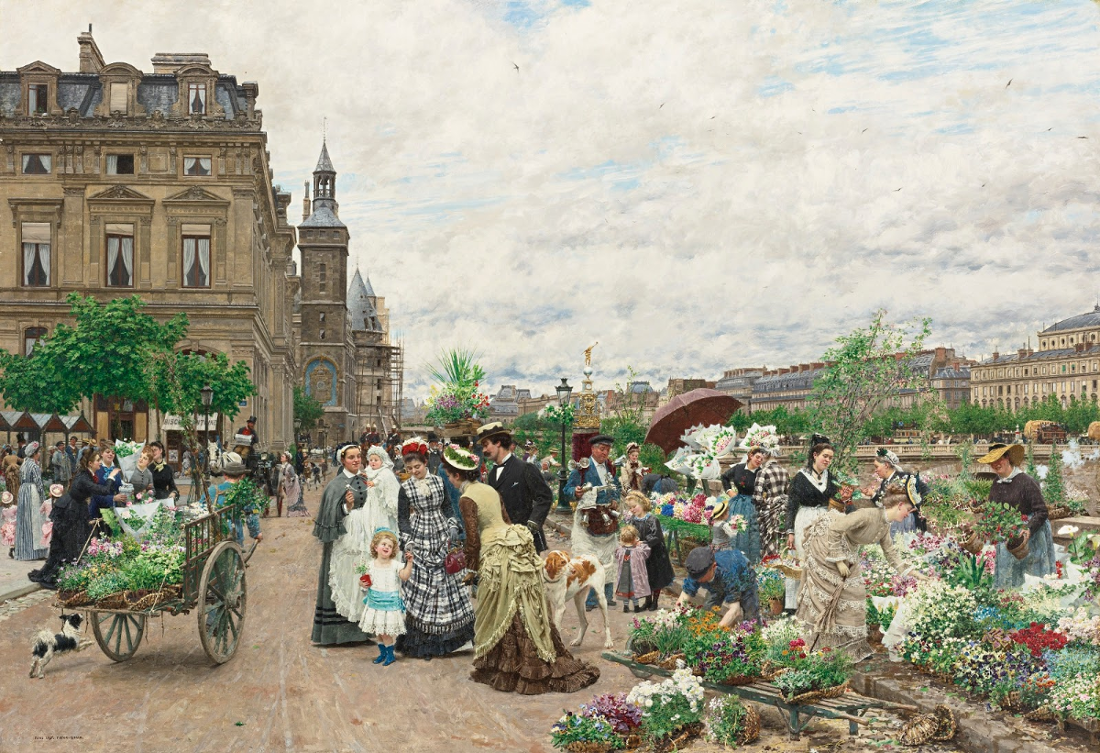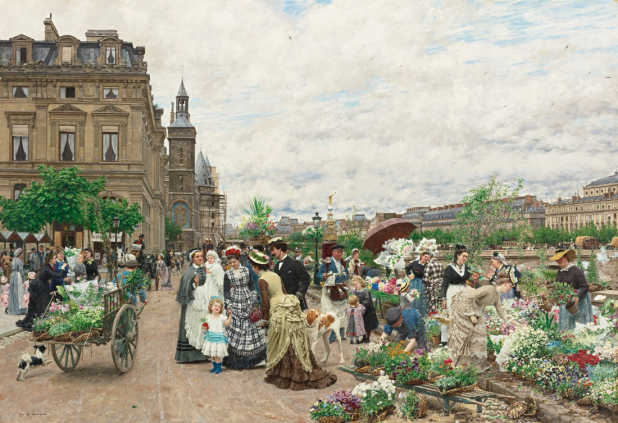Tory Scot
The Right Stuff
June 25, 2016
Through the early 1870s, Firmin-Girard’s submissions to the Paris Salon followed the shifting trends in public taste from historical subjects and scenes taken from the Siege of Paris to more fanciful Japonisme and Orientalist themes. While these compositions earned Firmin-Girard early accolades, his submission of Le Quai aux Fleurs to the Salon of 1876 would propel him to international fame. The large painting hung in a prominent spot facing the entrance to the Grand Salon, and the artist remembered “the crowd which was stationed continually before my picture and that it was not always easy to get near it” (from a letter republished in the catalogue of The Private Collection of the Late Theron Butler, 1910). At times police were required to control the throngs appreciating the work at the Salon, proving the highly detailed, densely populated Le Quai aux Fleurs invites careful and repeated viewing.
–Sotheby’s Catalogue Note
Did that jump out at you the same way that it did to me? Things certainly do change. When was the last time you heard of the police being called in to control large crowds gathering to admire a painting? Nowadays, if “large throngs” and “police” are mentioned in the same sentence you can be fairly certain that La Raza and Black Lives Matter are involved somehow.
The idea that paintings would attract crowds seems a little bizarre to us today, but in the Victorian era it wasn’t all that uncommon. Works that were particularly impressive (or controversial) would often lead to long lines of people waiting to see the painting. A good example of a painting that caused a stir in the public is Paton’s In Memoriam, a work commemorating the fate of British women during the Indian Mutiny of 1857. The painting depicted a room full of British women with Indians starting to come through the door. While this description alone will probably give you a fair idea of why the painting was controversial, it helps to keep in mind that the Cawnpore Massacre was fresh in British minds:
The surviving women and children, 210 in number, were spared to later face an even worse ordeal. They were marched back to town and incarcerated in a single-storey house, the Bibighur, the ‘House of Ladies’, built by an Englishman for his Indian mistress. Deprived of sustenance and suffering in the July heat, the prisoners weakened. After over two weeks of torment, on 15 July, Nana Sahib received news that a relieving force of British troops was on its way. Panicked, Nana ordered the women and children killed.
The sepoys dispatched to murder their captors found the task too distasteful, and so Nana ordered in professional butchers who, wearing aprons, showed no qualms in wielding their meat cleavers and swords. Amid the screams and blood, their sword blades broke from overwork. An hour later, they had finished their pitiless task, leaving over 200 dead and dismembered women and children. The following morning, they found three women and three children, aged under seven, covered in blood, quivering beneath the piles of dead bodies. They were thrown, one-by-one, down a 50-foot deep mine shaft, and there suffocated under the weight of corpses and body parts thrown in on top of them.
For some reason, although this rebellion was discussed in many of my University courses, usually with much lamenting over the poor oppressed Indians, this particular episode in the rebellion was never mentioned. I can’t imagine why.
The controversy over Paton’s painting became so great that he painted over the Indians, replacing them with Highlanders coming to the rescue. I can’t ever remember a painting causing so much furor in my lifetime.
In the place of Shakespeare plays, painting salons, and opera, we have (((Amy Schumer))) and Kanye West. It is a sad state of affairs.
Many on the right have correctly observed that pop culture, as it is called, is a sewer where discourse is reduced to the lowest common denominator. It aspires to nothing higher, it has few standards, and it is the perfect expression of egalitarian modernity. That is what our modern mass culture is.
Unfortunately, this precise observation is all too often followed up by an incorrect conclusion. Conservatives tend to dismiss mass culture as simply being irrelevant, or the inevitable result of culture reaching a mass audience. If culture is popular, then it must also be plebeian. Better to simply ignore it. Films are for children.
Let’s return to Le Quai aux Fleurs; It’s a painting from the late nineteenth century, and I would say a rather masterful one. The curators of the Paris Salon certainly thought so, since they gave it a prominent place in the 1876 Salon. It would be fair to saw that the work is a cultured one, and was a part of the culture of La Belle Epoque. It was also, as pointed out above so popular that it needed police protection. So if it was a work of culture, and it was popular, doesn’t that make it pop culture?
Yes. Yes it does.
If that surprises you, it shouldn’t. Culture that reaches the majority of people has not always necessarily been of low quality. Shakespeare’s plays were performed in front of large audiences of common people, as well as royalty of England. The Iliad and the Odyssey were meant to be read aloud by orators to crowds, and the plays of Sophocles would have been viewed by all classes of Greek society. Classical music isn’t exactly promoted among the masses by the guardians of media, yet many pieces of classical music are still well known among average people. They might ask “who?”, if you say Wagner’s name, but hum The Ride of the Valkyries and they’ll recognize the tune immediately. The idea that high culture can’t reach outside of small circles at the top of society is, quite simply, entirely false.
On occasion, something worth while even manages to get through the net, and is well received. Anyone who believes that there’s no market for quality culture needs to be reminded of the Lord of the Rings films. Tolkien’s writing has similarities to Wagner’s operas because they are both drawing water from the same well, namely Germanic mythology. There are criticisms that could be made of Peter Jackson’s portrayal of Middle Earth, but at the end of the day, one of the 21st century’s greatest film series was a Germanic Epic. The three films all together grossed over a billion dollars. Google “Lord of the Rings racist” and you will get plenty of results of people panicking over the films, which has done nothing to stop the overwhelming popularity of the trilogy.
Far from not wanting wholesome culture, people are crying out for it. The problem isn’t a lack of demand. If you build it they will come.
So, why is it that there is an abundance of garbage in our culture and a lack of quality?
It’s partly because egalitarianism has eroded the desire in the West to strive for something better. Ideas of superiority clash with egalitarian doctrine. To affirm that the Florentine Cathedral is of greater value than Piss Christ is basically fascism. If you think Bach was more of a genius than Kanye West, you’re not only a fascist, but probably a racist too!
It’s partly because of the leveling of society due to egalitarianism. The elite of Western civilization would patronize the arts, and from here the culture was influenced and guided. Aristocrats set the standards for the culture which effected the society as a whole–call it “trickle down culture”. Instead egalitarianism has had us abandon the principle of paternalism in favour of social anarchy. “Muh consenting adults, it doesn’t hurt me,” etc. Instead of trying to coax people into emulating higher standards, if anything the modern world celebrates those at the top of the social ladder acting as if they were at the bottom of it.
There’s another angle to this, however:
That the Jews dominate the art world, as they dominate the mass media and every other area of influence, is the best-kept secret of the twenty-first century. One is not supposed to mention this. It is anti-Semitic to do so.
In 1989, an erudite academic volume appeared called Sociology of the Arts. In it the authors discuss who is who in the art world. “Blacks, Orientals, and persons of Spanish origin constitute about 7 per cent of the art audience,” the book informs us helpfully. So what about the other 93 per cent?
What ethnic group owns most of the art galleries? Who are the museum curators? Who are the art historians? Who are the art critics? Who publish the magazines in which art is reviewed? Who determine what is good art and what is rubbish? Who are the dealers and big collectors? Who run the auction houses? Who set up the art competitions and raise the prize money? Who appoint the judges? Who are the judges?
Not a word. Total silence. Scary, isn’t it?
As far back as 1930, it was noted by French author Pierre Assouline: “According to dealer Pierre Loeb, four art dealers out of five are Jewish, as are four out of five art collectors. Wilhelm Unde added art critics to this list.” In 1973, it was estimated that 80 per cent of the 2500 core “art market personnel” — dealers, curators, gallery owners, collectors, critics, consultants and patrons of the arts — were Jewish. In 1982, Gerald Krefetz (Jewish) let the cat out of the bag even further. “Today, Jews enjoy every phase of the art world,” he admitted. “In some circles, the wheelers and dealers are referred to as the Jewish mafia.”
Writing of his experiences in New York City, Jewish author Howard Jacobson revealed that art critic Peter Schjedhal had told him, “Just about every gallery we go into is run by a Jew. Even the women gallery owners whose wine we absorb are Jewish.”
Our culture has been taken over by aliens, from the (((New York Intellectuals))) to (((modern art))). These are a people, who, as Voltaire correctly identified, are born with raging fanaticism in their hearts, and a hatred for the children of Europe. From the Daily Beast interview linked above:
When you started researching this topic, were you surprised that Jewish designers dominated the modern design movement?
Yes. I was surprised at the extent of it. That’s why the exhibition has a quantitative capacity of sorts. I wanted to gesture at the sheer number of designers who were involved. But I also wanted to ask the questions “why?” and “how?”
My questions exactly. In the early years—the 1920s and 1930s—modernism was seen as “out there.” Avant-garde. Sort of dangerous. And Jews were at the vanguard even then. (I’m thinking of the groundbreaking Los Angeles architects R.M. Schindler and Richard Neutra.) Why?
Many of those architects and designers came from a Europe where Jews were already at the forefront of modern movements in art, in design, in music, and so on. And that’s because—especially in Europe—history has [a] very negative connotation for Jews.
History is painful.
“History is painful, by which I mean your history is painful, goy. Into the trash!”
If you’re like me, when you think of European history you think of the mathematics of Newton, the sculptures of Michelangelo, the writings of Dante, the doctors of the Dutch Golden Age who pioneered our understanding of human anatomy, the inventions of the Victorians, the music of Beethoven, and the glories of Rome. That isn’t how Jews see us. To Jews, our history is nothing but pogroms, restrictions, hatred, and ultimately, Auschwitz. So it has to go. Art can’t be inspired by European history. So it has been decoupled from any white sensibility. It has to be pulled as far away from Da Vinci as possible, to the point that contemporary art is utterly meaningless. It isn’t even shocking anymore, it’s just dull. Nothing about the post-modern art scene is even new.
In 1964, a new avant-garde artist was introduced to the art scene in the Swedish city of Gōteborg. The fresh new artist was Pierre Brassau and his work received rave reviews from critics and art fans alike.
Brassau featured four paintings in the 1964 exhibition at Gallerie Christinae, and even sold one “masterpiece” to a collector named Bertil Eklöt for $90 (about $650 today). The exhibition featured paintings from artists across Europe, but it was the hot new French Artist who stole the show.
One critic in particular, Rolf Anderberg, was so overwhelmed by Pierre’s talent that he wrote the following review about his work, which appeared in print the morning following the exhibition:
“Brassau paints with powerful strokes, but also with clear determination. His brush strokes twist with furious fastidiousness. Pierre is an artist who performs with the delicacy of a ballet dancer.”
The reviews were glowing. All but one. One critic’s review was short and to the point: “Only an ape could have done this.”
The opinion was unpopular among the other critics, despite that the pieces of art looking strikingly similar to “art” you commonly see stuck to refrigerators, produced by 2 year olds the world over. It turns out, though, that the “ape” review more or less hit the nail on the head.
Pierre Brassau was actually none other than a young West African chimpanzee named Peter who lived in the Borås djurpark zoo in Sweden. The mastermind behind the hoax was journalist Åke “Dacke” Axelsson. Axelsson worked for the Swedish tabloid Gotebors-Tidningen and came up with the idea of featuring the primate paintings in an exhibition in order to put the critics to the test. Could they recognize the work of true avant-garde modern artists?
It’s not just that contemporary art is worthless, it’s that it has been worthless for decades now. The art scene has been like this for so long that it doesn’t even offend anyone anymore. The utter lack of standards has led to mastery being defined only by name recognition.
It’s a joke, and everyone (except those inside contemporary art circles) realizes it. Like so many of the branches of leftism, modern art has lost all credibility in the eyes of the public.
Those with actual artistic skill go into other areas now. As Bowden noted in his article on the famous concept artist Frank Franzetta (and elsewhere), talented artists who were unwilling to bend to the soul crushing Marxism of “high art” have gone into what those in New York galleries would deem to be “low brow” fields. Search for “concept art” on Google Images and you’ll find a type of inspiration and a level of talent that you wouldn’t find anywhere in the a hundred post modern art museums. Concept artists like Illya Nasarov (one of his works is shown below) are closer to the tradition of Caspar David Friedrich than anything you’ll find in the Guggenheim Museum.
There is still artistic talent out there, even if in our age it isn’t recognized properly. It has fled to concept art, graphic design, and other private sectors relating to aesthetics, but it is still there.
Even outside of these areas, there is still quality art being created. The Art Renewal Centre has made its mission the advancement of what it calls “realism” in art. The best definition of realism in art I can think of is “not finger painting”. To the question of “why realism?“, Frederick Ross answers:
My answer is direct, simple and should be self-evident: The visual fine arts of drawing, painting and sculpture are best understood first last and always as a language; a visual language. It was developed and preserved first and foremost as a means of communication very much like spoken and written languages. And like language it is successful if communication takes place and it is unsuccessful if it does not. This answer simultaneously defines the term “Fine Art.” So fine art is a way that human beings can communicate.
Here we have the real reason most contemporary art is so disdained; it is utterly meaningless and therefor can’t communicate anything.
Take a stroll through the ARC’s Living Master gallery and you’ll see that traditional styles of fine art have not gone entirely extinct. The talent is ignored, perhaps even suppressed, but it’s still there.
If art is to ever recover, and to advance, the values of our age must change. Egalitarianism has to go, because it is strangling us. In addition, the guardians of high culture must be people who aren’t hostile to our traditions and works that draw inspiration from those traditions.
Yes, culture is important, in fact, it’s at least as important as politics. Mass culture doesn’t have to descend into filth. It’s a mistake to forgo this fight, to ignore it out of a misplaced sense of snobbishness. If you’re “above” popular culture then you’re above fighting over the hearts and minds of our people–you’re above winning if you’re above popular culture.
Beauty matters, and we need to bring it back. I’m going to unceremoniously end this article by demanding that you watch the Roger Scruton documentary that I just linked. Seriously, watch it.



